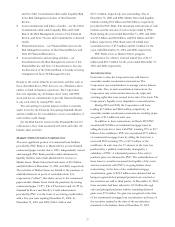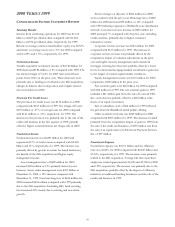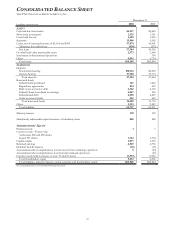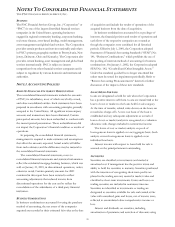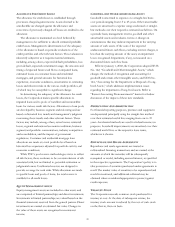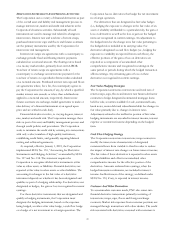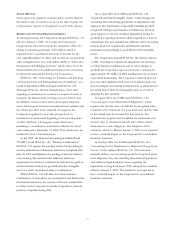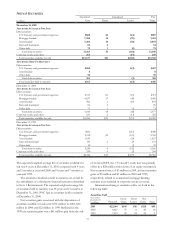PNC Bank 2001 Annual Report Download - page 68
Download and view the complete annual report
Please find page 68 of the 2001 PNC Bank annual report below. You can navigate through the pages in the report by either clicking on the pages listed below, or by using the keyword search tool below to find specific information within the annual report.NOTES TO CONSOLIDATED FINANCIAL STATEMENTS
THE PNC FINANCIAL SERVICES GROUP, INC.
66
BUSINESS
The PNC Financial Services Group, Inc. (“Corporation” or
“PNC”) is one of the largest diversified financial services
companies in the United States, operating businesses
engaged in regional community banking, corporate banking,
real estate finance, asset-based lending, wealth management,
asset management and global fund services. The Corporation
provides certain products and services nationally and others
in PNC’s primary geographic markets in Pennsylvania, New
Jersey, Delaware, Ohio and Kentucky. The Corporation also
provides certain banking, asset management and global fund
services internationally. PNC is subject to intense
competition from other financial services companies and is
subject to regulation by various domestic and international
authorities.
NOTE 1 ACCOUNTING POLICIES
BASIS OF FINANCIAL STATEMENT PRESENTATION
The consolidated financial statements include the accounts
of PNC, its subsidiaries, most of which are wholly owned,
and other consolidated entities. Such statements have been
prepared in accordance with accounting principles generally
accepted in the United States. All significant intercompany
accounts and transactions have been eliminated. Certain
prior-period amounts have been reclassified to conform with
the current period presentation. These reclassifications did
not impact the Corporation’s financial condition or results of
operations.
In preparing the consolidated financial statements,
management is required to make estimates and assumptions
that affect the amounts reported. Actual results will differ
from such estimates and the differences may be material to
the consolidated financial statements.
The consolidated financial statements, notes to
consolidated financial statements and statistical information
reflect the residential mortgage banking business, which was
sold on January 31, 2001, in discontinued operations, unless
otherwise noted. Certain quarterly amounts for 2001
contained in this report have been restated to reflect
accounting adjustments that reduced income from
discontinued operations for the year and to reflect the
consolidation of the subsidiaries of a third party financial
institution.
BUSINESS COMBINATIONS
In business combinations accounted for using the purchase
method of accounting, the net assets of the companies
acquired are recorded at their estimated fair value at the date
of acquisition and include the results of operations of the
acquired business from the date of acquisition.
In business combinations accounted for as poolings-of-
interests, the financial position and results of operations and
cash flows of the respective companies are restated as
though the companies were combined for all historical
periods. Effective July 1, 2001, the Corporation adopted
Statement of Financial Accounting Standards (“SFAS”) No.
141, “Business Combinations,” which prohibits the use of
the pooling-of-interests method of accounting for business
combinations. On January 1, 2002, the Corporation adopted
SFAS No. 142, “Goodwill and Other Intangible Assets.”
Under this standard, goodwill is no longer amortized but
rather must be tested for impairment periodically. Refer to
“Recent Accounting Pronouncements” herein for further
discussion of the impact of these new standards.
LOANS HELD FOR SALE
Loans are designated as held for sale when the Corporation
has a positive intent to sell them. Loans are transferred at the
lower of cost or market to the loans held for sale category.
At the time of transfer, related write-downs on the loans are
recorded as charge-offs. A new cost basis of the loan is
established and any subsequent adjustment as a result of
lower of cost or market analysis is recognized as a valuation
allowance with changes included in noninterest income.
The lower of cost or market analysis on pools of
homogeneous loans is applied on a net aggregate basis. Such
analysis on non-homogeneous loans is applied on an
individual loan basis.
Interest income with respect to loans held for sale is
accrued on the principal amount outstanding.
SECURITIES
Securities are classified as investments and carried at
amortized cost if management has the positive intent and
ability to hold the securities to maturity. Securities purchased
with the intention of recognizing short-term profits are
placed in the trading account, carried at market value and
classified as short-term investments. Gains and losses on
trading securities are included in noninterest income.
Securities not classified as investments or trading are
designated as securities available for sale and carried at fair
value with unrealized gains and losses, net of income taxes,
reflected in accumulated other comprehensive income or
loss.
Interest and dividends on securities, including
amortization of premiums and accretion of discounts using



